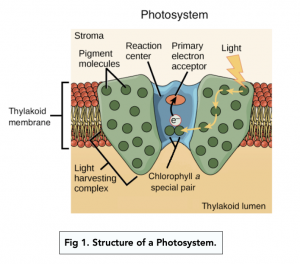Photosystems and Photosynthetic Pigments (A-level Biology)
Photosystems and Photosynthetic Pigments
Photosynthetic Pigments
Chloroplasts contain many pigments which are found within the thylakoid membranes. They are involved in absorbing light which is required during the process of photosynthesis.
The pigments colour is determined by the light they reflect, for example, chlorophylls reflect green light, giving chloroplasts their green colour. Having more than one pigment means there are more wavelengths of light, which in turn means more light energy is absorbed, making photosynthesis more efficient.
Chlorophyll is a mixture of photosynthetic pigments which absorb red and blue-violet light. There are two forms: chlorophyll a and chlorophyll b:

There are other pigments which are involved in photosynthesis: carotenoids, which prevent damage of chlorophyll and come in 2 forms, beta carotene (orange) and xanthophyll (yellow), as well as phaophytin, which is grey in colour.
Light Absorption
Photosynthetic pigments absorb light energy. Each pigment absorbs light at a particular wavelength. The combination of pigments ensures that all the different wavelengths of light in the visible light spectrum are absorbed, except for green light which is reflected (hence why plants look green).
Absorption spectrum is used to determine the wavelengths absorbed by specific pigments, showing the percentage of light absorbed at each wavelength.
Action spectrum helps to show the relationship between the rate of photosynthesis for a given wavelength.
There are two photosystems within the thylakoid membranes. Photosystem I and II are crucial for the light dependent reactions. The photosystems contain chlorophyll paired with a light absorbing complex. Photosystems also have an electron acceptor, which accepts electrons liberated during the photolysis of water.

Photolysis
As water dissociates into both hydrogen and hydroxide ions, the lost electrons are replaced in photosystems || in the chlorophyll. The electrons become excited and and electron acceptor passes them along an electron transport chain to reach NADP. This then takes up a H+ ion (from the dissociated water) where it forms reduced NADP. Water and oxygen are then formed after the hydroxide ions react together.
Photosystems and photosynthetic pigments are two key components of photosynthesis, the process by which plants and other organisms produce energy from light. Photosystems are complex structures within the chloroplasts of plants that capture light energy and use it to generate ATP and NADPH, which are used as energy sources for cellular processes. Photosynthetic pigments, such as chlorophyll, absorb light and transfer the energy to the photosystems.
During photosynthesis, light energy absorbed by photosynthetic pigments is transferred to the photosystems, where it is used to generate ATP and NADPH. These energy-rich molecules are then used to drive the process of carbon dioxide fixation, which produces glucose and other sugars that are used as energy sources by the plant.
There are several different types of photosynthetic pigments, including chlorophyll a, chlorophyll b, carotenoids, and phycobilins. Each pigment absorbs light in different parts of the light spectrum and contributes to the overall efficiency of photosynthesis.
Photosynthetic pigments are important in photosynthesis because they absorb light and transfer the energy to the photosystems, where it is used to generate ATP and NADPH. Without these pigments, plants and other organisms would not be able to produce energy from light and would not be able to survive.
The color of photosynthetic pigments is related to their function in photosynthesis because the color reflects the wavelengths of light that the pigment absorbs. Different pigments absorb different wavelengths of light, and this affects the overall efficiency of photosynthesis by influencing the amount of energy that is captured and transferred to the photosystems.
The light-dependent reactions are the first stage of photosynthesis, where light energy is captured and used to generate ATP and NADPH. These energy-rich molecules are then used in the light-independent reactions to drive the process of carbon dioxide fixation, which produces glucose and other sugars that are used as energy sources by the plant.
The light-independent reactions are the second stage of photosynthesis, where the energy from ATP and NADPH is used to drive the process of carbon dioxide fixation. During this process, carbon dioxide is converted into glucose and other sugars that are used as energy sources by the plant. The light-independent reactions occur in the stroma of the chloroplasts and do not require light.






Still got a question? Leave a comment
Leave a comment